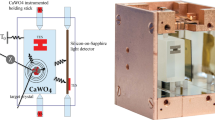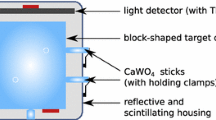Abstract
Super Cryogenic Dark Matter Search (SuperCDMS) [1] is a direct dark matter search experiment that has pioneered the use of low-temperature solid-state detectors to search for rare scattering of Weakly Interacting Massive Particles (WIMPs) [2] with atomic nuclei. The SuperCDMS Soudan experiment consisted 15 germanium detectors with a total mass of 9 kg.
Vijay Iyer on behalf of the SuperCDMS collaboration.
Access provided by Autonomous University of Puebla. Download conference paper PDF
Similar content being viewed by others
173.1 SuperCDMS Detector Physics and WIMP Search
Super Cryogenic Dark Matter Search (SuperCDMS) [1] is a direct dark matter search experiment that has pioneered the use of low-temperature solid-state detectors to search for rare scattering of Weakly Interacting Massive Particles (WIMPs) [2] with atomic nuclei. The SuperCDMS Soudan experiment consisted 15 germanium detectors with a total mass of 9 kg.
WIMPs and neutrons elastically scatter off a nucleus causing a nuclear recoil (NR) and generate electron-hole pairs. Gammas and \(\beta \) particles scatter primarily off electrons causing electron recoils (ER). A bias voltage V applied to the detector makes the charges drift along the electric field lines. This mechanical work done on the electron-hole pairs by the field is released to the lattice as Neganov-Trofimov-Luke (NTL) phonons [3] with an energy \(E_{NTL}=qVN\), where q is the charge of an electron and N is the number of electron-hole pairs created by the scatter event. All of the energy associated with a scatter event is eventually released in the form of phonons. E\(_\mathrm {total}\) is the sum of recoil energy, \(E_{R}\), and NTL phonon energy \(E_{NTL}\) that we measure in our detectors. The ionization yield Y is a relative measure of the number of electron-hole pairs created compared to the ER case. It is possible to write the total phonon energy as \(E_\mathrm {total}=E_{R}(1+qVY/\epsilon )\), where \(\epsilon \) is the average amount of recoil energy to create an electron-hole pair in the ER case (3.0 eV in Ge). NRs produce fewer electron-hole pairs than ERs and thus have an ionization yield less than 1. SuperCDMS detectors measure N and E\(_\mathrm {total}\).
The SuperCDMS Soudan detectors were operated in two modes, the interleaved Z-sensitive Ionization and Phonon detectors (iZIP) operated at 4V and the CDMS low ionization threshold experiment (CDMSlite) detectors which were operated at higher voltages between 25 and 70 V. The \(E_\mathrm {total}\) produced from an event can be amplified by the applied voltage. The higher the bias voltage, the more the contribution from \(E_\mathrm {NTL}\) per electron-hole pair. This reduces the recoil energy threshold, but the ability to distinguish between ER and NR is sacrificed because N is too small to be measured independently the total phonon energy signal. Hence a direct measurement of Y is not possible for CDMSlite detectors. On the other hand, iZIPs possess the ability to discriminate between ERs and NRs [4].
173.2 Motivation and Photo-Neutron Calibration Concept
Dark matter search results are usually shown in the parameter space of dark matter-nucleon interaction cross section as a function of dark matter mass. If no dark matter-like events are found, an exclusion limit or curve is set based on the physical reach of an experiment. The motivation for a dedicated calibration of the SuperCDMS detectors comes from the fairly wide uncertainty in the exclusion curve [4] using CDMSlite data shown in Fig. 173.1a. The uncertainty comes from limited precision in determining the nuclear recoil energy scale. This stems from the inability of the CDMSlite detectors to measure the ionization yield as described in the previous section. An accurate understanding of the nuclear recoil energy scale is necessary for establishing the WIMP mass scale. CDMSlite makes use of the Lindhard model to predict the yield. The yield [5] can be written as follows:
where \( g(\epsilon ) = 3\epsilon ^{0.15} + 0.7\epsilon ^{0.6}+\epsilon , k = 0.133 Z^{2/3} A^{- 1/2}, \epsilon = 11.5E_{R}Z^{- 7/3}.\)
Here Z is the atomic number and A is the atomic mass number of the recoiling nucleus, \(\varepsilon \) a reduced energy term, E\(_{R}\) is the recoil energy in keV and k describes the electronic energy loss. While the value of k is usually fixed at 0.157 for Ge using the original Lindhard theory, k is treated as a free parameter in this analysis. The model works reasonably well at recoil energies greater than 10 keV, as seen in Fig. 173.1b. More data points below 1 keV are needed to ascertain the reliability of this model at lower recoil energies. The photo-neutron calibration will provide data as low as \(\sim \)1 keV.
The calibration technique here involves using a high rate \({}^{88}\)Y or \({}^{124}\)Sb \(\gamma \) source placed next to a Be absorber. The \(\gamma \) source and Be wafer were placed above the detector. \({}^{124}\)Sb and \({}^{88}\)Y emit \(\gamma \)s of 1.69 MeV and 1.84 MeV, respectively. Following a \({}^{9}\)Be(\(\gamma \),n) reaction the \({}^{124}\)Sb+Be and \({}^{88}\)Y+Be sources produce neutrons between 22.8–24.1 keV and 151–159 keV, respectively. In case of \({}^{124}\)Sb, the maximum recoil of the Ge nucleus is around 1.3 keV and for \({}^{88}\)Y around 8.1 keV. By studying the recoils of Ge nuclei from these quasi-monoenergetic neutrons, the measured total phonon energy \(E_\mathrm {total}\) of our detectors can be calibrated to the recoil energy \(E_{R}\).
173.3 Analysis
The entire analysis can be divided in to three main parts: (i) Data selection, (ii) Simulation, and (iii) Yield extraction.
Data was taken in two modes:(i) with the \(\gamma \) + Be source (neutron on) and (ii) with just the \(\gamma \) source(neutron off). The first part of the analysis starts by subjecting the data to several quality checks to remove electronic glitches, low frequency noise, poorly reconstructed events, and bad periods of data. The neutron on and neutron off data for yttrium from iZIP detectors are shown in Fig 173.2a. To obtain the total phonon energy NR spectrum, neutron off data was subtracted from the neutron on data. Fig 173.2b shows the residual spectrum that is dominated by neutrons for yttrium beryllium data.
With the knowledge of the relationship between \(E_\mathrm {total} \) and \(E_{R} \) as discussed in Sect. 173.2, one can then deduce the corresponding yield. The photo-neutron sources allow the determination of the ionization yield over the energy range covered by the resulting recoil spectrum. The second part of the analysis is simulating the expected \(E_{R} \) spectrum in the detector. The third part of the analysis is to compare the simulated neutron on \(E_\mathrm {total} \) spectrum to the measured neutron on \(E_\mathrm {total} \) spectrum. To determine the best fit, we use a negative log likelihood (NLL) function given by
where \(N_{D}\) is the number of events in a dataset and \(\rho _{D} \) is the energy-dependent PDF of the data spectrum. To obtain the simulated \(E_\mathrm {total} \) spectrum from the simulated \(E_{R} \) spectrum, a yield function \(Y(E_{R}) \) which takes the form shown in (173.1) is used. The detector resolution and cut efficiencies are applied to the simulated \(E_\mathrm {total} \) spectrum. The value of k in (173.1) is allowed to vary such that the negative log likelihood function is minimum. Statistical uncertainty on the simulated data is calculated by repeating the procedure with 500 simulated data samples of equal statistics and finding out the standard deviation of the best fit value of k in each case. Systematic uncertainty in the energy-dependent neutron-nucleus scattering cross section in germanium detector also needs to be accounted for. This can be done by obtaining cross section files for all the stable isotopes of Ge from the TENDL-2017 [6] nuclear database and repeating the NLL method to show the deviation in the best fit values of k.
173.4 Summary
The Lindhard model is known to have limited accuracy at low energies. Given the significant progress in lowering the recoil energy threshold for SuperCDMS, determination of yield at lower recoil energies has become increasingly important for SuperCDMS [1]. The results from the work described in this analysis will be helpful in putting more precise limits on SuperCDMS dark matter search results.
References
R. Agnese et al., SuperCDMS collaboration. Phys. Rev. D 95, 082002 (2017)
G. Jungman, M. Kamionkowski, K. Griest, Phys. Rept. 267, 195–373 (1996)
B. Neganov et al., Otkryt. Izobret 146, 215 (1985)
R. Agnese et al., SuperCDMS collaboration. Phys. Rev. Lett. 116, 071301 (2016)
P. Luke, J. Appl. Phys. 64, 6858 (1988)
D. Barker, D.-M. Mei, Astropart. Phys. 38, 1 (2012)
Author information
Authors and Affiliations
Corresponding author
Editor information
Editors and Affiliations
Rights and permissions
Copyright information
© 2021 Springer Nature Singapore Pte Ltd.
About this paper
Cite this paper
Iyer, V. (2021). Photo-Neutron Calibration of SuperCDMS Detectors. In: Behera, P.K., Bhatnagar, V., Shukla, P., Sinha, R. (eds) XXIII DAE High Energy Physics Symposium. DAEBRNS HEPS 2018 2018. Springer Proceedings in Physics, vol 261. Springer, Singapore. https://doi.org/10.1007/978-981-33-4408-2_173
Download citation
DOI: https://doi.org/10.1007/978-981-33-4408-2_173
Published:
Publisher Name: Springer, Singapore
Print ISBN: 978-981-33-4407-5
Online ISBN: 978-981-33-4408-2
eBook Packages: Physics and AstronomyPhysics and Astronomy (R0)






